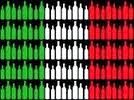 |
| Massive Vinitaly! |
ProWein certainly has much more of an international focus. Wine producers from some 50 countries in all five continents, ranging from China and Uruguay to Slovenia and England, were present, and visitors were certainly international with a significant number of Asian faces. Most exhibitors were grouped by country and region whereas WSET had three booths strategically located in different sections. In contrast, Vinitaly’s exhibitors were at least 90% home grown and visitors were largely European.
So, from the above observations, ProWein and Vinitaly are not truly direct competitors. Which fair you choose to exhibit at or visit depends on what you are looking for.
 |
| Wines from Turkey and Switzerland |
 |
| Wines of South Africa self-tasting booth at ProWein |
Vinitaly, in comparison, was somewhat more chaotic. We were in a group led by Vinitaly staff but, even so, entrance to the venue was not always straightforward. Restaurants opened late even though there were queues of people waiting, and they ran out of food if you were too late. It seemed that most people were driving, so you can imagine the traffic around the venue. Although I don’t mind sharing a fair with consumers, their number was overwhelming, especially on the first day (I later found out that the first day, the Sunday, was indeed the ‘official’ consumer day). I was tasting and writing notes at one booth when a group of loud ladies came by, sat at the table and started ordering wine as if they were in a bar. The lady I was talking to went to serve them, and eventually I just walked away without tasting any more from that booth. By early afternoon groups of half-drunk teenagers were everywhere and some had to be taken out by ambulance.
The attitude of exhibitors at the two fairs was also very different. At Vinitaly, perhaps because it largely caters for local visitors and perhaps also because of the language barrier, I found most exhibitors not very inviting. The gates opened at 9:30 but by 10:30 some exhibitors were still not ready. As I walked around, most of them (both big and small) did not seem to want to make eye contact let alone invite me to try their wine, so I ended up doing more walking than tasting, although, having said that, once I was welcomed to a booth, exhibitors were all enthusiastic. In contrast, the exhibitors at ProWein clearly had more international experience, and tastings were always conducted in a professional and efficient manner.
So which is better? ProWein Düsseldorf is an international platform bringing together wine producers and buyers from all over the world, whereas Vinitaly Verona is about showcasing Italian wines to largely European buyers (although they are gearing up to attract more international exhibitors). Sp, if your heart is with Italy, Vinitaly is definitely a fair not be missed but if you want to have a bit of everything, and especially if you are on the lookout for wines from smaller regions, you won’t be disappointed with ProWein. And both fairs are starting to venture beyond their home turf. ProWine has expanded to Shanghai (ProWine CHINA), aiming to bring international wine producers to Chinese buyers, while Vinitaly has organised shows in several major international cities including New York, Moscow, Hong Kong, Shanghai and Chengdu, helping Italian wine producers develop new markets. Yet their essential characters still remain the same: ProWein caters for international wine producers while Vinitaly largely serves Italian wine producers.
As for me, I enjoyed both, mainly because as I was able to try lots of wines that are not available in Hong Kong. I loved the well-organised ProWein and the very well-planned and efficient itinerary arranged by my host, Wines of Germany. Vinitaly could certainly borrow some efficiency from ProWein but our host, Vinitaly International, made up for it with additional programmes, especially OperaWine featuring 100 top Italian producers (although at just two hours long it was way too short), and the various fabulous dinners. Allegrini, with its welcoming laser show and stunning outdoor audio-visual presentation, was something I shall never forget.
Thank you both Wines of Germany and Vinitaly International for providing such wonderful learning and experience.



